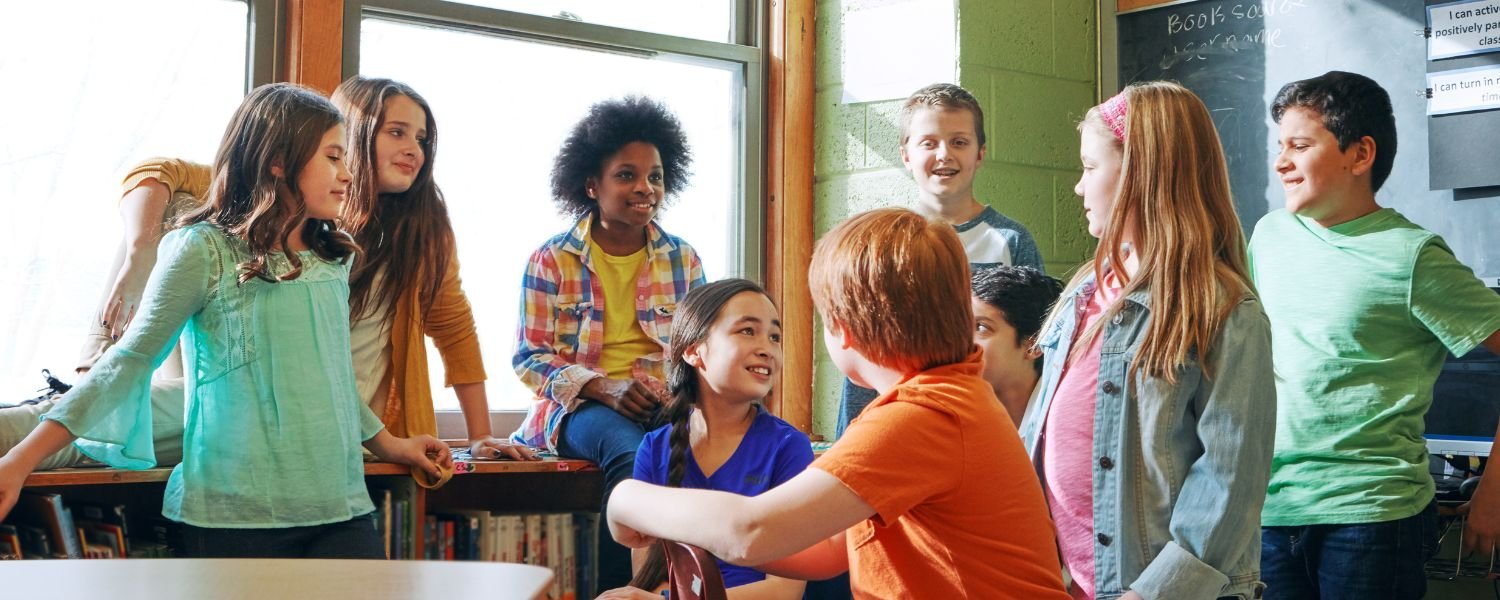In today’s increasingly complex world, there’s more to education than merely teaching reading, writing, and arithmetic.
One crucial component of emotional mastery that’s often overlooked is social-emotional learning (SEL).
An article from Publishers Weekly discusses its significance and how it’s transforming the education landscape.
Let’s dive into mastering the power of social-emotional learning, using insights from the article and beyond.
1. What is Social-Emotional Learning?

Social-emotional learning (SEL) is a comprehensive process through which individuals, particularly students, learn to understand, express, and manage their emotions in healthy and productive ways.
It also includes setting and working toward positive personal goals, developing empathy for others, and learning how to interact and maintain strong, positive relationships.
Additionally, SEL helps individuals to make thoughtful and responsible decisions that benefit themselves and those around them.
At the core of SEL is emotional intelligence, which provides individuals with the tools to recognize and regulate their emotions.
This emotional mastery is essential for creating an environment that is both safe and conducive to learning, allowing students to thrive academically, socially, and emotionally.
By fostering these crucial skills, SEL not only improves a student’s ability to succeed in school but also equips them with the capabilities needed to navigate challenges in their future careers and throughout life.
In essence, social-emotional learning supports the development of well-rounded individuals who can manage stress, communicate effectively, and collaborate with others in meaningful ways, all of which contribute to their overall well-being and success.
2. Why is SEL Crucial?

Social-emotional learning (SEL) is critical because it goes beyond the traditional focus of education, which primarily emphasizes academic achievements.
While academic success is important, SEL adds an essential dimension to students’ development, ensuring their growth is well-rounded and holistic.
It nurtures emotional intelligence, self-awareness, and interpersonal skills, all of which play a pivotal role in shaping students into capable, well-adjusted individuals.
One of the key benefits of SEL is that it helps students gain a deeper understanding of themselves and their relationships with others.
This self-awareness not only makes them more resilient but also better prepares them to face the challenges and uncertainties of life.
With SEL, students are given the tools to navigate personal struggles, overcome setbacks, and adapt to the constantly changing world around them.
1. Enhanced Academic Performance
Contrary to the common belief that focusing on emotional skills might detract from academic achievement, numerous studies show that SEL actually boosts academic performance.
When students are able to manage their emotions, they become more focused, less distracted, and better equipped to handle the pressures of schoolwork.
Emotional mastery allows them to approach their studies with a clearer mindset, which improves their concentration, critical thinking, and problem-solving abilities.
As a result, their academic outcomes often improve, proving that emotional and academic growth can go hand in hand.
2. Improved Relationships
SEL plays a vital role in helping students build stronger relationships with others, whether it’s with their peers, teachers, or family members.
By teaching empathy, SEL fosters the ability to understand and share the feelings of others, which is the cornerstone of healthy, respectful relationships.
Additionally, SEL equips students with effective communication skills and the ability to appreciate different perspectives.
This leads to a more harmonious and collaborative environment both inside and outside of school, where students learn how to resolve conflicts peacefully and work together toward common goals.
3. Mental Health and Well-being
In today’s world, where mental health challenges are becoming increasingly prevalent among young people, SEL serves as a powerful tool for prevention and early intervention.
By teaching students valuable coping strategies and emotional regulation techniques, SEL helps them build resilience in the face of adversity.
It empowers them to manage stress, anxiety, and other negative emotions more effectively, thus improving their overall mental health.
As a result, SEL contributes to a more positive and supportive environment for students, reducing the risk of emotional and behavioral issues while enhancing their overall well-being.
3. SEL in Action: Books and Beyond

Social-emotional learning (SEL) can be effectively promoted through books and everyday school activities.
Publishers Weekly highlights how literature acts as both mirrors and windows for children.
Books that reflect a child’s emotions help them understand their feelings, while stories that offer a glimpse into others’ lives broaden their empathy and perspective.
These stories enable children to grasp complex emotions, empathize with characters, and learn important SEL lessons.
Many authors and publishers are now intentionally including SEL themes in their works, ensuring children have access to content that supports their emotional and social development.
Beyond books, SEL can be incorporated into daily school activities.
Group projects teach teamwork and communication, while classroom discussions on books or current events encourage empathy and critical thinking.
These activities promote SEL by helping children develop emotional intelligence and social skills in real-life contexts.
4. Challenges in Implementing SEL

While the advantages of social-emotional learning (SEL) are widely recognized, there are several significant challenges that can hinder its successful implementation in schools and educational settings:
1. Lack of Understanding
One of the primary obstacles to SEL is the lack of awareness or understanding among some educators, parents, and even policymakers.
Many individuals may not fully grasp the importance of SEL in fostering well-rounded, emotionally intelligent students.
As a result, there is often a greater emphasis placed on traditional academic achievements—such as test scores and grades—while emotional and social growth may be seen as secondary or less important.
This mindset can make it difficult to prioritize SEL within the educational framework, even though it is essential for students’ overall development and success.
2. Time Constraints
Another significant challenge is the limited time available within the school day to implement SEL effectively.
With rigorous academic schedules and a growing emphasis on standardized testing, teachers are often under pressure to focus primarily on core subjects like math, science, and language arts.
This can leave little room for SEL activities, which require dedicated time and space for students to engage in meaningful discussions, reflection, and emotional skill-building exercises.
As a result, it becomes difficult to consistently integrate SEL into daily learning routines, even though it plays a crucial role in students’ well-being and academic performance.
3. Inadequate Training
For SEL to be implemented effectively, teachers must have the necessary training and resources to support their students in developing social-emotional skills.
However, many educators are not provided with sufficient professional development in this area. Without proper training in SEL principles, strategies, and techniques, teachers may struggle to incorporate SEL into their lessons or classroom culture.
Additionally, many teachers may not feel confident in addressing emotional or social challenges in the classroom, leading to missed opportunities for fostering important emotional intelligence skills among students.
Proper training, support, and resources are crucial to overcoming this barrier and ensuring SEL is integrated effectively into educational settings.
5. Overcoming the Challenges

To unlock the full potential of social-emotional learning (SEL), it is crucial for schools, educators, and parents to work together to prioritize, support, and implement SEL strategies effectively.
Here are the key steps to make this happen:
1. Prioritize SEL
It’s essential to recognize that SEL is just as important as academic achievement in shaping students’ overall success.
By treating SEL as a priority, schools can allocate the necessary time, attention, and resources to integrate it into the curriculum.
This includes not only scheduling time for SEL activities but also ensuring that teachers and administrators understand its importance and are committed to fostering an emotionally supportive environment.
When SEL is treated as a core component of education, students are better equipped to manage their emotions, build strong relationships, and navigate challenges, all of which ultimately enhance their academic and personal success.
2. Provide Training
For SEL to be effectively integrated into the classroom, educators must receive proper training and ongoing professional development.
Teachers need to be equipped with the skills, strategies, and resources to teach SEL and address emotional and social issues in a constructive way.
This training should cover various SEL competencies, such as emotional regulation, conflict resolution, and empathy-building.
By providing teachers with the tools they need, schools can ensure that SEL becomes a natural and consistent part of daily lessons.
Additionally, ongoing support and resources should be made available so educators can continuously refine their SEL practices and adapt them to meet the needs of their students.
3. Collaborate
The success of SEL implementation requires strong collaboration among multiple stakeholders—publishers, educators, and parents.
Publishers play a critical role by producing books and educational materials that incorporate SEL themes, allowing children to engage with content that promotes emotional and social growth.
However, it is equally important for educators and parents to work together to ensure that SEL content is used effectively in the classroom and at home.
Parents can reinforce SEL lessons by fostering a supportive environment at home, encouraging emotional expression, and practicing empathy with their children.
Educators, meanwhile, can integrate SEL into daily classroom activities and provide feedback on how parents can support SEL at home.
By aligning efforts across these groups, SEL can be reinforced consistently in both educational and home environments, helping children to thrive emotionally, socially, and academically.
6. The Road Ahead

The future of social-emotional learning (SEL) is bright, as its significance becomes increasingly recognized across educational landscapes.
With growing awareness and an expanding body of research that underscores its benefits, more schools are actively integrating SEL into their curricula.
This shift reflects a deeper understanding that academic success is just one part of a student’s development, and that emotional and social growth is equally important for their well-being and long-term success.
As part of this movement, publishers are stepping up by producing a wide range of books and educational materials that support SEL, providing children with resources that promote empathy, emotional intelligence, and effective communication.
At the same time, educators are being provided with the tools and professional development they need to incorporate SEL effectively into their teaching methods.
Teachers are now better equipped to guide students through the process of understanding and managing their emotions, building strong relationships, and making responsible decisions.
However, while the progress is encouraging, the road ahead requires continued effort and commitment.
It’s essential to recognize that SEL is not a one-time lesson or a temporary initiative—it is a lifelong journey.
To truly harness the power of SEL, it must be woven into the fabric of daily life, consistently practiced and reinforced over time.
This means creating an environment where social-emotional skills are continuously nurtured, both at school and at home.
By doing so, we are not only helping students become more successful learners but also preparing them to be empathetic, resilient, and responsible individuals who are ready to navigate the complexities of the world.
Ultimately, by embracing SEL, we are investing in the development of a generation that is emotionally intelligent, capable of thriving in diverse environments, and equipped to face the challenges of the future.
Conclusion
The journey of mastering the power of social-emotional learning is one of profound significance in the realm of personal development and education.
Social-emotional learning equips individuals with the essential life skills necessary for success in various aspects of life.
Through this exploration, we have delved into the fundamental importance of recognizing and harnessing our emotions, as well as understanding the intricate interplay between our social interactions and emotional well-being.
It not only enhances our ability to navigate relationships and communicate effectively but also empowers us to manage stress, develop resilience, and make sound decisions.
As we have seen, the benefits of social-emotional learning extend far beyond the classroom, influencing our professional careers, personal relationships, and overall quality of life.

